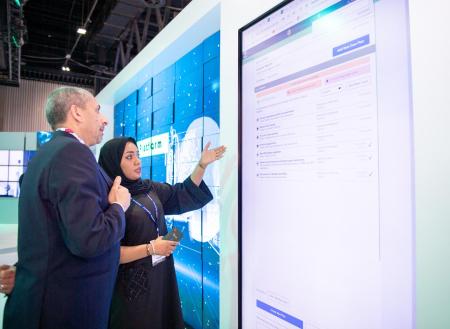As part of its participation in the Arab Health 2020, Dubai, the Ministry of Health and Prevention, MoHAP, showcased the latest updates of its innovative project ‘PaCE’ (Performance and Clinical Excellence), which was established in accordance with the artificial intelligence technologies, massive data analysis, and predictive modeling.
Visitors to the Arab Health, exhibitors, and those interested can watch live reports on the award-winning center after obtaining more than 10 global awards, the last of which was the Gold Award at the World Hospital Congress of the International Hospital Federation (IHF) and the ‘Limitless Business Intelligence Dashboard’ award at the IBIS Business Intelligence Dashboard Awards.
“MoHAP takes pride in the key role of PaCE in integrating the AI by 100% into health services, in line with the UAE Strategy for Artificial Intelligence and the UAE Centennial 2071, in addition to attracting future treatment protocols. This comes as part of MoHAP’s strategy to provide comprehensive, innovative, and fair healthcare services as per international standards, and to develop health information systems,” said H.E. Dr. Youssif Al Serkal, Assistant Undersecretary for the Ministry’s Hospitals Sector.
Source of Data and Future Clinical Research
Al Serkal highlighted PaCE’s fundamental role in reducing hospital stay re-entry in intensive care departments, hospital-acquired infection, and mortality rates, and increasing patients’ happiness by providing specialized and timely care, adding that the center will also be used as a source of data and information, and conduction of clinical and developmental future research, and decision-making.
A Virtual Digital Assistant
“MoHAP is applying the solutions of cognitive artificial intelligence (CAI) to “Pace”, which is operating as a virtual digital assistant in all stages of health care. This would help enhance the quality of health care and well-being in society by simulating human understanding of the context and pathogens in society. Also, PaCE works to proactively monitor medications, pathogens, and vulnerabilities in health care plans, by using the smart application linked to the electronic medical record, which focuses on individual health. This would help ensure adherence to treatment, and allow patients to participate in making treatment decisions with health care providers,” he explained.
Dr. Kalthoum Al Baloushi, Director of MoHAP’s Hospitals Administration, said: “PaCE contains CAI-based dashboards featuring live and predictive statistics related to the operational indicators of the hospital, such as the number of hospitalized patients and their movements between hospitals. Other data provided by PaCE is the patient flow into trauma and emergency departments and bed management and time management to reduce waiting rates, in order to improve resource management and ensure safety and quality.”
This is in addition to clinical observations recorded by medical staff in the electronic health record which is processed in the natural language and integrated proactively with doctors’ recommendations in health care plans.
The Two-Way Audiovisual Content Technology
Al Baloushi noted that the third phase of PaCE project will focus on achieving meaningful use of administrative procedures, clinical quality measures and bed occupancy rate, and detailed daily monitoring of staff, family and patients, in accordance with the types of diagnosis, the Relative Value Unit (RVU) as per the physician, specialty and hospital, hospital quality measures for inpatient services, re-admission rate according to the service line, specialization, and the use of operating rooms, radiology, and other resources within the MoHAP’ hospital resources.
“PaCE is developed to help the medical and nursing staff in the operations center to easily and safely access patient data in intensive care departments while ensuring the highest levels of confidentiality. PaCE can also detect in advance complications that might happen to patients. This would help reduce medical errors down to prevent it completely. PaCE’s control system will then send all vital patient data directly from the hospital’s intensive care department to the operations center in the hospital sector, through the two-way audiovisual content technology,” she concluded.




